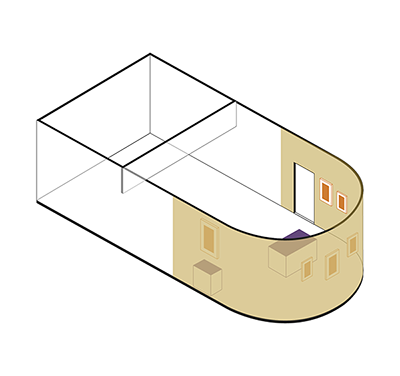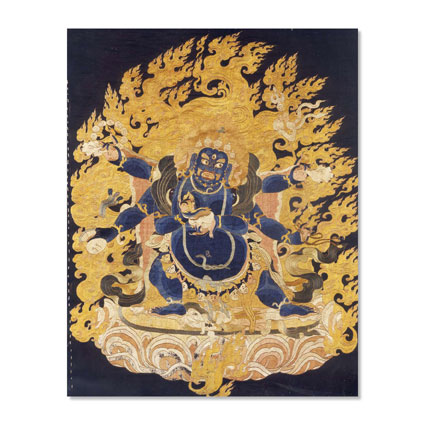Shadbhuja Mahakala – The "Six-armed Great Black One"
See it in the Museum

Chapel
Orientation 1
Wall object 8

ABP 013
Code: ABP 013
Country: Tibet or China
Style:
Date: 1600 - 1700
Dimensions in cm WxHxD: 46.5 x 59.5
Materials: Silk Embroidery Thanka
The six-armed and three-eyed form of Mahakala (Tib.: mGon po phyag drug pa («gönpo chag drugpa») also known as Shadbhuja Mahakala, tramples on the Hindu god Ganesha. In the upper right hand Mahakala holds a skull garland (mundamala), in the upper left a trident (trishula). The principal hands hold a chopper (karttrka) and a skull cup (kapala); the lower right a double drum (damaru), the lower left a noose (pasha).
Heritage of Tibet Zwalf p.73
Heritage of Tibet Zwalf p.73
Mahakala
(From Wikipedia, the free encyclopedia)
Mahakala is a Dharmapala("protector of dharma") in Vajrayana Buddhism (Tibetan Buddhism and Japanese Shingon Buddhism).
In Japanese Buddhism, Mahakala (Jpn: Daikoku), belongs to the fourth hierarchy of deities (tenbu).
Name
Mahakala is a Sanskrit bahuvrihi of maha ("great") and kala ("black"). The Tibetan name is Gonpo Phyag (Wylie: mGon po phyag ).
Description
Mahakala is relied upon in all schools of Tibetan Buddhism. However, he is depicted in a number of variations, each with distinctly different qualities and aspects. He is also regarded as the emanation of different beings in different cases, namely Avalokiteshvara (Tib: Chenrezig) or Chakrasamvara (Tib: Korlo Demchog, Wylie: ’khor-lo bde-mchog).
Mahakala is typically black in color. Just as all colors are absorbed and dissolved into black, all names and forms are said to melt into those of Mahakala, symbolizing his all-embracing, comprehensive nature. Black can also represent the total absence of color, and again in this case it signifies the nature of Mahakala as ultimate or absolute reality. This principle is known in Sanskrit as "nirguna", beyond all quality and form, and it is typified by both interpretations.
Mahakala is almost always depicted with a crown of five skulls, which representing the transmutation of the five kleshas(negative afflictions) into the five wisdoms.
The most notable variation in Mahakala's manifestations and depictions is in the number of arms, but other details can vary as well. For instance, in some cases there are Mahakalas in white, with multiple heads, without genitals, standing on varying numbers of various things, holding various implements, with alternative adornments, and so on.
Manifestations
Six-Armed Mahakala
The Six-Armed Mahakala (Skt: Shad-bhuja Mahakala, Wylie: mGon po phyag drug pa) is favored by the Gelug order of Tibetan Buddhism, and in this manifestation is considered to be a fierce and powerful emanation of Avalokitesvara, the bodhisattva of compassion.
He is adorned with the following symbolic attributes:
1. The Six Arms signify the successful completion of the six perfections (shad-paramita), which are practiced and brought to perfection by bodhisattvas during the course of their training.
2. various implements in each hand.
There is also a White Six-Armed Mahakala (Skt: Shad-bhuja Sita Mahakala; Tib. Wylie: mGon po yid bzhin nor bu) popular among Mongolian Gelugpas. In this case, he is a "wealth deity", specifically supporting the comfort and economic well-being of tantric practitioners. As such, his iconography differs in form and symbolism, with his skull bowl containing various jewels rather than the typical mortal remains of his victims, and a crown of jewels instead of skulls. The following description is found in his sadhana: "His body is white. His face is wrathful and he has three eyes. He has six arms. His main right hand holds a wish-fulfilling jewel (cintamani) mounted on a jewel-tipped handle, in front of his chest."
Four-Armed Mahakalas
Various Four-armed Mahakalas (Skt. Chatur-bhuja Mahakala, Tib. Wylie: mGon po phyag bzhi pa) are the primary protectors of the Karma Kagyu and Drikung Kagyu schools of Tibetan Buddhism. A four-armed Mahakala is also found in the Nyingma school, although the primary protector of the Great Perfection (Skt: Mahasandhi, Tib. Dzogchen) teachings which are the pinacle of the Nyingma system is Ekajati.
The four arms of this manifestation of Mahakala perform one of the following four positive karmas or actions, which are said to be his specific boon to his worshippers:
* Pacify sickness, hindrances, and troubles.
* Increase life, good qualities and wisdom.
* Attract whatever Dharma practitioners need and bring people to the Dharma.
* Destroy confusion, doubt, and ignorance.
Two-Armed Mahakalas
The two-armed Mahakala called Bernakchen is a protector of the Karma Kagyu school. It is often thought to be the primary protector, but it is actually the main protector of the Karmapas specifically.
Panjaranatha Mahakala, 'Lord of Charms" or "Lord of the Pavilion", an emanation of Manjushri is a protector of the Sakya order.
(From Wikipedia, the free encyclopedia)
Mahakala is a Dharmapala("protector of dharma") in Vajrayana Buddhism (Tibetan Buddhism and Japanese Shingon Buddhism).
In Japanese Buddhism, Mahakala (Jpn: Daikoku), belongs to the fourth hierarchy of deities (tenbu).
Name
Mahakala is a Sanskrit bahuvrihi of maha ("great") and kala ("black"). The Tibetan name is Gonpo Phyag (Wylie: mGon po phyag ).
Description
Mahakala is relied upon in all schools of Tibetan Buddhism. However, he is depicted in a number of variations, each with distinctly different qualities and aspects. He is also regarded as the emanation of different beings in different cases, namely Avalokiteshvara (Tib: Chenrezig) or Chakrasamvara (Tib: Korlo Demchog, Wylie: ’khor-lo bde-mchog).
Mahakala is typically black in color. Just as all colors are absorbed and dissolved into black, all names and forms are said to melt into those of Mahakala, symbolizing his all-embracing, comprehensive nature. Black can also represent the total absence of color, and again in this case it signifies the nature of Mahakala as ultimate or absolute reality. This principle is known in Sanskrit as "nirguna", beyond all quality and form, and it is typified by both interpretations.
Mahakala is almost always depicted with a crown of five skulls, which representing the transmutation of the five kleshas(negative afflictions) into the five wisdoms.
The most notable variation in Mahakala's manifestations and depictions is in the number of arms, but other details can vary as well. For instance, in some cases there are Mahakalas in white, with multiple heads, without genitals, standing on varying numbers of various things, holding various implements, with alternative adornments, and so on.
Manifestations
Six-Armed Mahakala
The Six-Armed Mahakala (Skt: Shad-bhuja Mahakala, Wylie: mGon po phyag drug pa) is favored by the Gelug order of Tibetan Buddhism, and in this manifestation is considered to be a fierce and powerful emanation of Avalokitesvara, the bodhisattva of compassion.
He is adorned with the following symbolic attributes:
1. The Six Arms signify the successful completion of the six perfections (shad-paramita), which are practiced and brought to perfection by bodhisattvas during the course of their training.
2. various implements in each hand.
There is also a White Six-Armed Mahakala (Skt: Shad-bhuja Sita Mahakala; Tib. Wylie: mGon po yid bzhin nor bu) popular among Mongolian Gelugpas. In this case, he is a "wealth deity", specifically supporting the comfort and economic well-being of tantric practitioners. As such, his iconography differs in form and symbolism, with his skull bowl containing various jewels rather than the typical mortal remains of his victims, and a crown of jewels instead of skulls. The following description is found in his sadhana: "His body is white. His face is wrathful and he has three eyes. He has six arms. His main right hand holds a wish-fulfilling jewel (cintamani) mounted on a jewel-tipped handle, in front of his chest."
Four-Armed Mahakalas
Various Four-armed Mahakalas (Skt. Chatur-bhuja Mahakala, Tib. Wylie: mGon po phyag bzhi pa) are the primary protectors of the Karma Kagyu and Drikung Kagyu schools of Tibetan Buddhism. A four-armed Mahakala is also found in the Nyingma school, although the primary protector of the Great Perfection (Skt: Mahasandhi, Tib. Dzogchen) teachings which are the pinacle of the Nyingma system is Ekajati.
The four arms of this manifestation of Mahakala perform one of the following four positive karmas or actions, which are said to be his specific boon to his worshippers:
* Pacify sickness, hindrances, and troubles.
* Increase life, good qualities and wisdom.
* Attract whatever Dharma practitioners need and bring people to the Dharma.
* Destroy confusion, doubt, and ignorance.
Two-Armed Mahakalas
The two-armed Mahakala called Bernakchen is a protector of the Karma Kagyu school. It is often thought to be the primary protector, but it is actually the main protector of the Karmapas specifically.
Panjaranatha Mahakala, 'Lord of Charms" or "Lord of the Pavilion", an emanation of Manjushri is a protector of the Sakya order.
Bock, Etienne; Falcombello, Jean-Marc; Jenny Magali, 2022. Trésors du Tibet. Sur les pas de Milarépa.. Paris: Flammarion. p. 139
Zwalf, Wladimir, 1981. Heritage of Tibet. London: British Museum Publ.. P. 73

